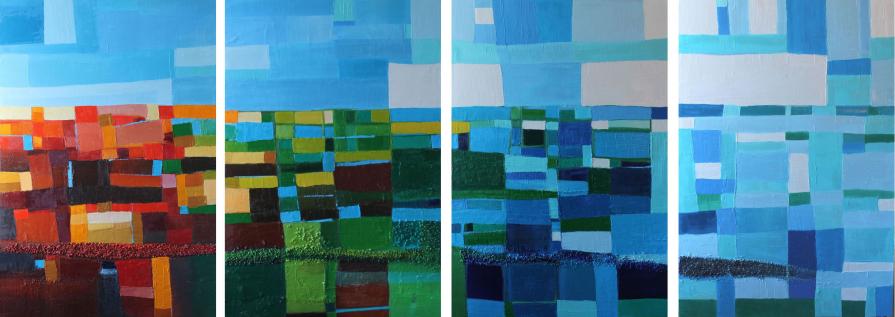
I quattro elementi
Individuali eppure congiunti, speciali nella propria essenza e tuttavia paritari tra loro (da cui lo sviluppo in orizzontale del lavoro), diversi ma in fondo riconducibili a una radice comune: così Vincenza Benedetto interpreta qui gli antichi elementi della natura, Fuoco, Terra, Acqua e Aria, scegliendo, come spesso accade nel suo “fare” artistico, di creare un’opera composita, dove singole tele, che hanno una vita propria e che all’interno sembrano a loro volta diramarsi in singoli tasselli, si uniscono configurando una realtà ulteriore, che le supera (arricchendole) pur mantenendole integre.
La sua non è un’anatomia o una fisiologia degli elementi (non li descrive o non spiega come funzionano, anche se qualche indizio in effetti ce lo dà): è, potremmo dire, una loro fisiognomica, un tentativo di indovinare, partendo dal loro aspetto esteriore (o meglio da quell’immagine che soggettivamente si ritiene tale), i caratteri significativi, cioè le qualità portatrici di senso, di valenze “umane”, concettuali, emozionali. Insomma è una visione sentita degli elementi, anzi, per essere più precisi, un sentire gli elementi reso visibile. L’artista solo in parte li osserva per quello che sono o per quello che magari la tradizione ha suggerito che devono essere, ma li sente e li vive, perché l’arte, come a Van Gogh piaceva dire, è l’uomo aggiunto alla natura.
La potenza del Fuoco, la solidità della Terra, la multiformità dell’Acqua e la leggerezza dell’Aria sono inevitabilmente tradotte in forme astratte, perché all’astrattismo appartiene la grammatica dell’artista. Ma, il suo, è sempre un “astrattismo materico”, un linguaggio che intende armonizzare due termini contrari (non è forse la materia quanto di più concreto, e quindi di meno astratto, possa esistere? E non è forse l’astrazione quanto di più spirituale, e pertanto di meno materico, si possa immaginare?) attraverso un percorso creativo che parte dal dato oggettivo e perviene alla sintesi formale, che manifesta un’idea grazie alla materia. Dunque forme astratte, ma anche forme piene di energia – a ben vedere è l’energia, la potenzialità di vita, quanto accomuna i quattro elementi – conseguite attraverso l’impiego di più tecniche, che si stratificano tra loro generando un intimo dialogo di materiali, colori e immagini che conquista i nostri occhi emozionando l’anima.
The brotherhood of the four elements
Individual and together, special in their essence but also equal (that is why the work is horizontal), different but with a same root at the same time: that is how Vincenza Benedetto interprets the old elements of nature, Fire, Earth, Water and Air, choosing, as it often happens in her art, to create a composite work, where single canvas, with their own life, seem to spread in single tiles and join to set an additional reality that surpasses (enhancing) them, even if they remain intact.
Hers is not an anatomy or physiology of the elements (she does not describe them, she does not explain how they work, even if she gives us some tips): it is, we could say, their physiognomy, an attempt to guess, from their appearance (or better, from our subjective point of view), their main characters, that is their meaningful, “human”, conceptual and emotional qualities. Therefore it is a vision felt by the elements, or, to be more precise, a feeling of the elements made visible. The artist, only in part, sees them as they are or as the tradition suggested they should be, but she feels and lives them, because Art, as Van Gogh liked to say, is the man joined to nature.
The power of Fire, the solidity of the Earth, the multiform quality of Water, and the lightness of the Air are necessarily translated into abstract shapes, because Abstract Art belongs to the grammar of the artist. But, hers, is always a “material abstract art”, a language that wants to balance two opposites (isn’t matter, maybe, the most tangible, and so the least abstract thing that can exist? And isn’t abstraction the most spiritual, and so, the least material concept, you can imagine?) through a creative process that starts from objective datas and arrives at the synthesis of the shape showed by the matter itself. Therefore we can see abstract shapes, full of energy - because energy is the power of life that joins the four elements - obtained with different techniques that forms layers of a deep dialogue among materials, colours or images that conquer and move us.










Commenti 0
Inserisci commento